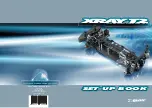
Before you start adjusting your car set-up to maximize the car’s performance and ease of handling, you should ensure the following:
• Car is in good mechanical shape with no broken, binding, or loose parts.
• Car has proper weight balance front/rear and left/right.
You should always try to adjust the weight on your car so it is equal left-to-right; this will help to ensure proper, consistent handling. You can use balancing
tools to check the weight distribution of your car, and ensure that your ready-to-race car does not list to one side.
We recommend using #107880 HUDY Chassis Balancing Tool. You would then place the chassis on the points of the stands so that the stand are
along the car’s centerline at the front and rear. If the car lists to one side (for example, to the left), add weight to the other side (say, to the right)
until the car stays level when left untouched.
The center-of-gravity (CG) of the car is the point on the car (in dimensional space) around which the car moves, and the point at which all force is
applied while the car is in motion.
• When the car goes around a corner, centrifugal force pushes the car to the outside of the turn, and that force pushes on the car’s CG causing the
car to tilt or roll to the outside. This transfers weight to the outside wheels of the car.
• When the car accelerates, the force pushes backward on the car’s CG, causing the car to tilt backward. This transfers weight from the front wheels
to the rear wheels.
• When the car brakes, the force pushes forward on the car’s CG, causing the car to tilt forward. This transfers weight from the rear wheels to the
front wheels.
Center-of-gravity is affected by the physical weight of the car, and the placement of all components on the car. If the car is not equally balanced
front/rear and left/right, the car’s CG will not be centered. This will cause the car to handle differently when it turns one direction as opposed to the
other direction.
It is always best to make the car’s CG as low as possible to minimize the negative effects of weight transfer. Do this by placing all components down
as low as possible on the car’s chassis, and reduce the weight that is up high.
WeIGHT TrAnSfer AnD cAr SeT-Up
Every aspect of car set-up affects the way that weight transfers on the car. There is no one magical set-up change that will solve all of your car’s
handling problems. Car set-up is a complex interaction of the various components that make up the car, and all of these aspects of set-up will affect
one another. Car set-up is always a matter of compromise.
WEIGHT BaLaNcE
WEIGHT TRaNSFER
Weight transfer is the key to car handling. Consider that a car has a certain amount of
“weight” on various parts of the car and this weight is distributed by a certain amount
into each wheel. When the car corners, weight is transferred to the outside tires, when
it accelerates weight is transferred to the rear, and when it brakes weight is transferred
to the front. By transferring weight to one side of the car (left or right) or one end of
the car (front or rear), the tires on that side (or at that end) will be forced onto the
racing surface more, resulting in more grip or traction.The amount of weight transfer
is affected by the car’s center-of-gravity (CG), the distribution of the weight by the car’s
setup, and by the way that you drive.
cENTER-OF-GRavITY
WEIGHT TRANSFER






































